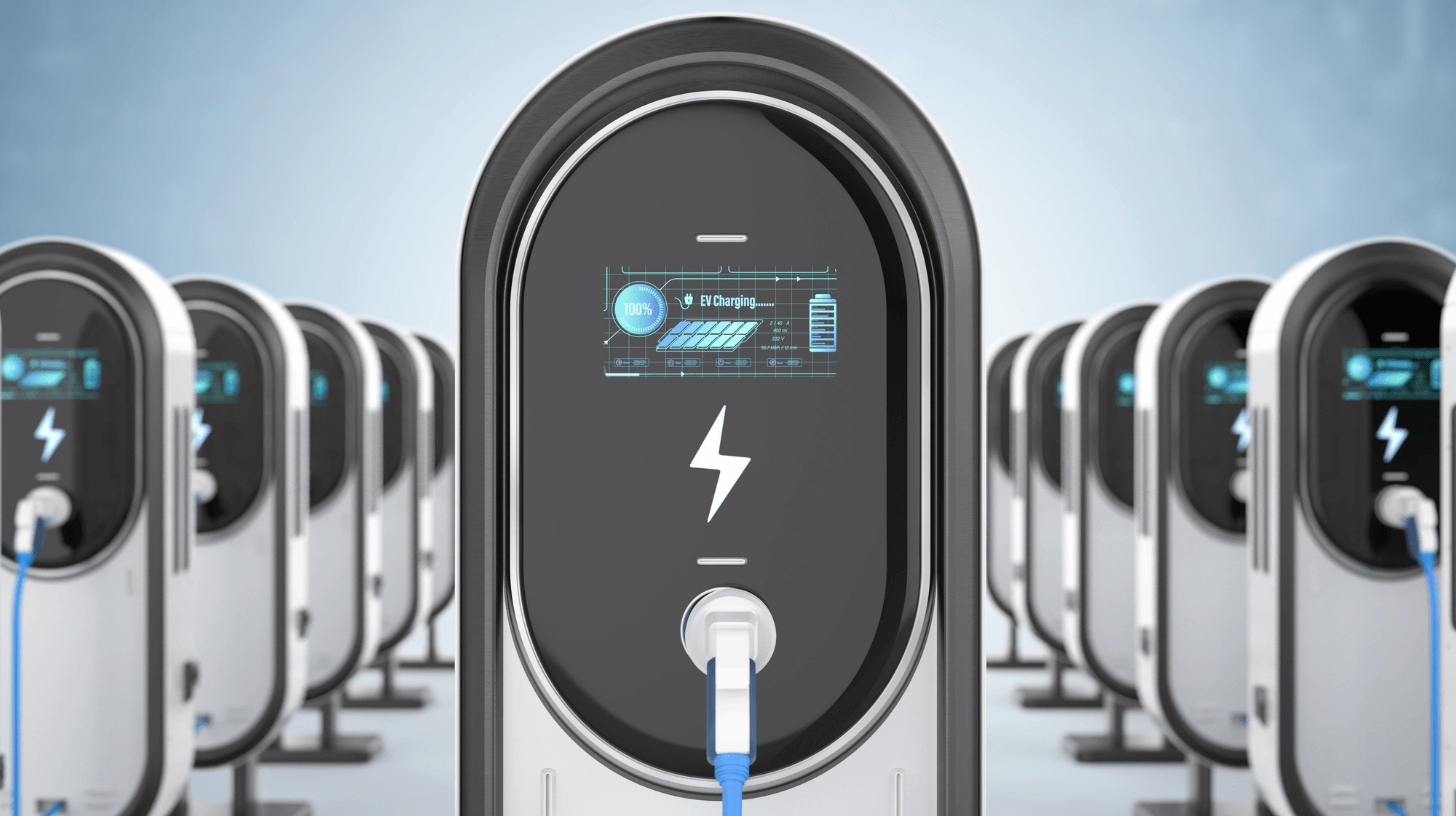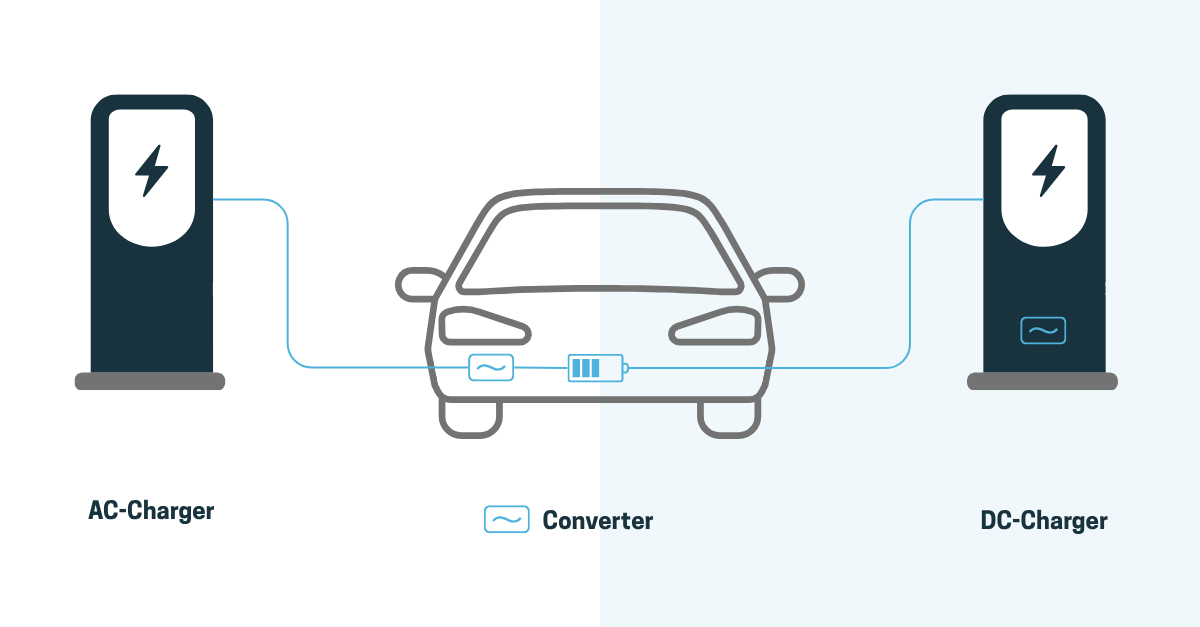AC or DC charging? How smart charging and OCPP make fleet charging efficient


More and more companies are electrifying their vehicle fleets. But anyone planning charging infrastructure soon faces a central question: AC or DC charging? In the past, this was primarily a matter of charging speed and cost. Today, there’s another key factor: communication. Modern charging infrastructure is more than just power delivery – it’s connected, intelligent, and controllable.
This article explains the difference between AC and DC charging, the role of communication standards such as OCPP, OCPI, and ISO 15118, and why smart charging is essential for efficient fleet operations.
With AC charging (alternating current), the vehicle itself converts the alternating current into direct current using an onboard charger. This process limits charging power – usually to 11 or 22 kW.
AC charging is ideal for locations where vehicles remain parked for longer periods, such as depots, logistics hubs, or employee parking areas.
Advantage: lower installation costs and higher grid compatibility.
With DC charging (direct current), the conversion from AC to DC takes place inside the charging station itself. This allows higher charging power – from 50 kW up to 350 kW or more.
DC charging is ideal for fleets with high vehicle turnover, shorter downtimes, or for fast-charging along routes.
Disadvantage: higher investment and grid connection costs – but maximum operational flexibility.
An EV battery can only store direct current (DC). During AC charging, the vehicle converts the alternating current into direct current via the onboard charger before storing it in the battery. With DC charging, this conversion takes place directly in the charging station, allowing direct current to flow straight into the battery.

| Feature | AC charging | DC charging |
| Current type | Alternating current | Direct current |
| Conversion | Inside the vehicle | Inside the charging station |
| Power output | 11-22 kW | 50-350 kW |
| Ideal for | Long-term parking, depot charging | En route or fast charging |
| Cost | Lower | Higher |
| Communication | Simpler | More complex, requires backend connection |
Both technologies have their place within a well-designed charging infrastructure – the optimal setup usually combines AC and DC charging points.
Modern charging infrastructure must do more than supply electricity – it must communicate: with vehicles, backend systems, and the power grid.
This communication is based on open protocols that ensure interoperability and long-term flexibility.
OCPP is the global standard for communication between charging stations and backend systems. It enables remote monitoring, maintenance, authentication, and intelligent load management. The latest version, OCPP 2.0.1, is designed for future features such as Plug & Charge and Vehicle-to-Grid (V2G).
OCPI connects different backend systems, making it possible to link multiple locations or operators. This is especially relevant for fleets that use external charging points or shared infrastructure.
This standard enables direct communication between the vehicle and the charging point. Its benefits include automatic authentication (Plug & Charge), enhanced security, and in the future, support for bidirectional charging (V2G).
Together, these standards ensure that charging infrastructure remains open, flexible, and manufacturer-independent.
Efficient electric mobility goes beyond plugging in. For a fleet to operate economically and reliably, charging, vehicles, and energy flows must work together intelligently.
A simple load management system controls power distribution – but without insight into fleet operations, it’s effectively blind.
A true smart charging and fleet management system combines both worlds:
The result: reduced idle times, lower electricity costs, and maximum operational readiness.
Through one central software platform, all charging points, vehicles, and energy sources can be managed. The system automatically responds to electricity prices, grid loads, and operational requirements – transparently and at scale. This creates a charging infrastructure that integrates seamlessly into both the energy system and daily operations.
Since 2024/2025, regulatory frameworks have also become crucial for smart charging.
Under §14a of the German Energy Industry Act (EnWG), charging points for electric vehicles are classified as controllable consumption devices. This allows grid operators to temporarily reduce or shift charging power during peak loads – in return, businesses benefit from lower grid fees.
For companies, this means that charging infrastructure should already be communication-enabled and controllable to take advantage of future cost benefits. Open standards such as OCPP 2.0.1 and ISO 15118 provide the technical foundation.
👉 Read more: Remote control technology & 14a EnWG: Making EV charging infrastructure grid-compatible
Electric mobility is evolving rapidly. Topics like bidirectional charging (Vehicle-to-Grid) and Plug & Charge will become increasingly relevant as vehicles are integrated into the energy system.
Today, however, adoption in Germany remains limited: only a few vehicles and charging stations are ready for bidirectional operation. Still, it’s worth preparing now – by investing in open communication standards such as OCPP and ISO 15118. This ensures your infrastructure is future-ready, when new features like V2G or grid-responsive charging become part of everyday operations.
AC and DC are not competitors but complementary building blocks of an efficient fleet strategy. The key is interoperability – ensuring that all systems, from wallbox to energy management, communicate seamlessly.
Companies investing in charging infrastructure today should focus on open standards, smart charging, and integrated fleet management. That’s the path to a fleet that’s not only mobile, but also cost-efficient and ready for the energy future.
AC or DC – as long as it’s smartly planned.
We help you design and implement charging infrastructure that fits your fleet – efficiently, economically, and future-ready.
👉 Book your free consultation now
Questions about the product?
Send an email to
Technical questions?Send an email to
Support-Tel.:
+49 461 402 142-10